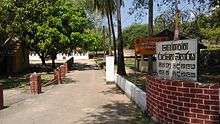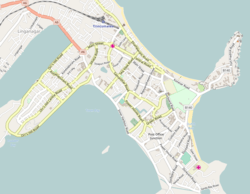Gokanna Vihara
Gokanna Viharaya (Sinhala: ගෝකන්න විහාරය) was an ancient Buddhist temple located in Trincomalee in the Eastern Province of Sri Lanka. The temple lies in the premises of Fort Fredrick close to the fort entrance.
| Gokanna Historic Buddhist Temple | |
|---|---|
ගෝකන්න විහාරය | |
 The entrance way of the Vihara preises | |
| Religion | |
| Affiliation | Buddhism |
| District | Trincomalee |
| Province | Eastern Province, Sri Lanka |
| Location | |
| Location | Fort Fredrick, Trincomalee, Sri Lanka |
 Shown within Central Trincomalee | |
| Geographic coordinates | 08°34′36.4″N 81°14′29.8″E |
| Architecture | |
| Type | Buddhist Temple |
| Completed | 6th century B.C |
History
According to the references of Sri Lanka Archaeological Department, Trincomalee had been known as Gokanna in the ancient times. Information reveals by chronicles such as Mahavamsa and Chulavamsa the Gokanna Vihara was built by the King Mahasen in the 3rd century (275-301 AD)[1][2] by destroying a Jaina monastery that existed on the Swami Rock,[3] where the Koneswaram Kovil stands today. It is said that in the reign of King Agbo V, the temple was modified by adding a preaching hall.[1]
In the 11th century A.D. when the Chola Empire invaded Sri Lanka, it was through the Gokanna port. They then extended their power from the Gokanna region to the Polonnaruwa kingdom. It was King Vijayabahu who restored Gokanna port as a commercial trade point after expelling the Chola invaders in the year 1070 A.D. The country was once again under threat in the year 1215 A.D. due to the invasion of Kalinga Magha, who set up a fortress at Gokanna. It was King Parakramabahu I who redeemed the port from these invaders. Aside from these invasions, there were conflicts between the Sinhala kings and the Arya Chakravarthi war loads who ruled Jaffna time to time over the ownership of the port.[4]
Destruction
The temple was destroyed in 1624 A.D by the Portuguese general Constantine De Saa[3] to construct a fort there.[5] According to the Portuguese historian De Queyroz, the Gokana Vihara was a Buddhist temple until it was destroyed by Portuguese in the 16th century.[6] As his records the temple structures were demolished by general Constantine De Saa while Buddhist monks were still in residence there.[6] As well as a Tamil rock inscription which was found near the main entrance to the fort, states that the Hindu temple that existed at this place was destroyed by the Portuguese.[3] By proving these facts number of archaeological evidences those are related to Buddhist and Hindu traditions have been found within the fort premises.
Vandalizing and destruction of Buddhist archeological remains takes place regularly. on the 5th of December 2015, secretively expansion of the have been recommenced of the new Koneshwaram Temple despite the archaeological department has prohibited any building materials such as sand, cement or bricks to be brought into the area. Large scale construction seen today to the left side of the Kovil was build in the immediate aftermath. Archaeologists from the archaeological Department who investigated despite protests from the Hindu Kovil trustees discovered that the artifacts that had been unearthed three years previously had gone missing.[7]
Present
With time the old Gokanna Vihara site was gradually become a site for the Hindus to worship and the current Kovil which has been built in 1856.[6] In correspondence from the Government Agent of Trincomalee, dated 8 October 1964, to the Secretary, Ministry of Cultural Affairs, it states that the Bodhi tree in front of the Koneswaram Kovil had been destroyed.[8] Recently divers have discovered submerged Buddhist and Hindu sculptures in nearby sea area and brought them ashore.[3]
References
- "satmag01". Island.lk. Retrieved 28 October 2014.
- "Funday Times". Sundaytimes.lk. Retrieved 28 October 2014.
- "Trincomalee Fort Fredrick". Sri Lanka Archaeological Department. Retrieved 4 September 2016.
- https://roar.media/english/life/history/gokanna-trincomalee-of-the-ancient-days/
- Ancient Ceylon-The journal of the Archeological Dept
- "Gokanna Viharaya at Trincomalee – ත්රිකුණාමලය ගෝකන්න විහාරය". Amazinglanka. Retrieved 4 September 2014.
- http://www.island.lk/index.php?page_cat=article-details&page=article-details&code_title=137257%20link
- Cyril Mathew (1983). An Appeal to UNESCO to Safeguard and Preserve the Cultural Property in Sri Lanka Endangered by Racial Prejudice, Unlawful Occupation, Or Wilful Destruction. Books.google.lk. Retrieved 28 October 2014.